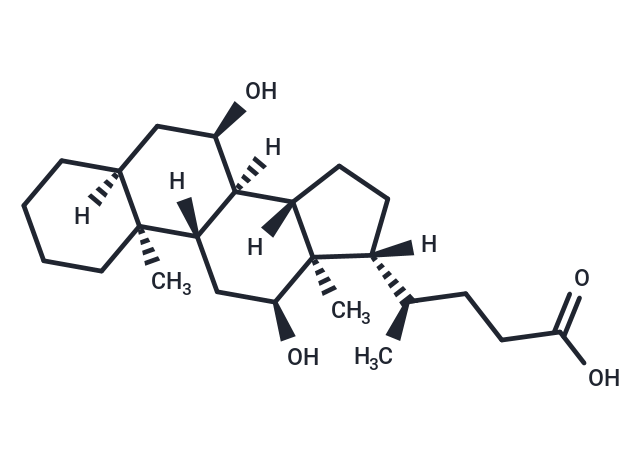 Your shopping cart is currently empty
Your shopping cart is currently empty

Isodeoxycholic Acid is a bile acid that is formed via epimerization of deoxycholic acid by intestinal bacteria. It has a greater critical micelle concentration than DCA, indicating reduced detergent activity, and is less active than DCA in inhibiting growth in a panel of seven gut commensal bacteria species. Isodeoxycholic Acid(0.1%) inhibits spore germination induced by taurocholic acid in several C. difficile strains, as well as decreases the cytotoxicity of C. difficile culture supernatants to Vero cells. Plasma levels of isodeoxycholic acid are decreased in a rat model of high-fat diet-induced obesity compared with rats fed a normal diet.

| Pack Size | Price | USA Warehouse | Global Warehouse | Quantity |
|---|---|---|---|---|
| 1 mg | $55 | In Stock | In Stock | |
| 5 mg | $197 | In Stock | In Stock | |
| 10 mg | $322 | In Stock | In Stock | |
| 25 mg | $622 | In Stock | In Stock | |
| 50 mg | $879 | In Stock | In Stock | |
| 100 mg | $1,180 | In Stock | In Stock |
| Description | Isodeoxycholic Acid is a bile acid that is formed via epimerization of deoxycholic acid by intestinal bacteria. It has a greater critical micelle concentration than DCA, indicating reduced detergent activity, and is less active than DCA in inhibiting growth in a panel of seven gut commensal bacteria species. Isodeoxycholic Acid(0.1%) inhibits spore germination induced by taurocholic acid in several C. difficile strains, as well as decreases the cytotoxicity of C. difficile culture supernatants to Vero cells. Plasma levels of isodeoxycholic acid are decreased in a rat model of high-fat diet-induced obesity compared with rats fed a normal diet. |
| In vitro | Isodeoxycholic acid (0.1%) inhibits spore germination induced by taurocholic acid in several C. difficile strains, as well as decrease the cytotoxicity of C. difficile culture supernatants to Vero cells.[3] |
| Synonyms | isoDCA |
| Molecular Weight | 392.57 |
| Formula | C24H40O4 |
| Cas No. | 566-17-6 |
| Smiles | C[C@@]12[C@@]3([C@]([C@]4([C@](C)([C@@H](O)C3)[C@@]([C@@H](CCC(O)=O)C)(CC4)[H])[H])([C@H](O)C[C@@]1(CCCC2)[H])[H])[H] |
| Storage | Powder: -20°C for 3 years | In solvent: -80°C for 1 year | Shipping with blue ice/Shipping at ambient temperature. | ||||||||||||||||||||||||||||||||||||||||
| Solubility Information | DMF: 27 mg/mL (68.78 mM), Sonication is recommended. Ethanol: 18 mg/mL (45.85 mM), Sonication is recommended. DMSO: 122.5 mg/mL (312.05 mM), Sonication is recommended. DMF:PBS (pH 7.2) (1:1): 0.5 mg/mL (1.27 mM), Sonication is recommended. | ||||||||||||||||||||||||||||||||||||||||
| In Vivo Formulation | 10% DMSO+90% Corn Oil: 1.5 mg/mL (3.82 mM), Sonication is recommeded. Please add the solvents sequentially, clarifying the solution as much as possible before adding the next one. Dissolve by heating and/or sonication if necessary. Working solution is recommended to be prepared and used immediately. The formulation provided above is for reference purposes only. In vivo formulations may vary and should be modified based on specific experimental conditions. | ||||||||||||||||||||||||||||||||||||||||
Solution Preparation Table | |||||||||||||||||||||||||||||||||||||||||
Ethanol/DMF/DMSO
DMF/DMSO
DMSO
| |||||||||||||||||||||||||||||||||||||||||
| Size | Quantity | Unit Price | Amount | Operation |
|---|

Copyright © 2015-2025 TargetMol Chemicals Inc. All Rights Reserved.